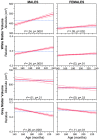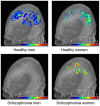A comparative, developmental, and clinical perspective of neurobehavioral sexual dimorphisms
- PMID: 22701400
- PMCID: PMC3372960
- DOI: 10.3389/fnins.2012.00084
A comparative, developmental, and clinical perspective of neurobehavioral sexual dimorphisms
Abstract
Women and men differ in a wide variety of behavioral traits and in their vulnerability to developing certain mental disorders. This review endeavors to explore how recent preclinical and clinical research findings have enhanced our understanding of the factors that underlie these disparities. We start with a brief overview of some of the important genetic, molecular, and hormonal determinants that contribute to the process of sexual differentiation. We then discuss the importance of animal models in studying the mechanisms responsible for sex differences in neuropsychiatric disorders (e.g., drug dependence) - with a special emphasis on experimental models based on the neurodevelopmental and "three hits" hypotheses. Next, we describe the most common brain phenotypes observed in vivo with magnetic resonance imaging. We discuss the challenges in interpreting these phenotypes vis-à-vis the underlying neurobiology and revisit the known sex differences in brain structure from birth, through adolescence, and into adulthood. This is followed by a presentation of pertinent clinical and epidemiological data that point to important sex differences in the prevalence, course, and expression of psychopathologies such as schizophrenia, and mood disorders including major depression and posttraumatic stress disorder. Recent evidence implies that mood disorders and psychosis share some common genetic predispositions and neurobiological bases. Therefore, modern research is emphasizing dimensional representation of mental disorders and conceptualization of schizophrenia and major depression as a continuum of cognitive deficits and neurobiological abnormalities. Herein, we examine available evidence on cerebral sexual dimorphism to verify if sex differences vary quantitatively and/or qualitatively along the psychoses-depression continuum. Finally, sex differences in the prevalence of posttraumatic disorder and drug abuse have been described, and we consider the genomic and molecular data supporting these differences.
Keywords: addiction; adolescence; animal models; bipolar disorders; depression; posttraumatic disorders; schizophrenia; sexual differentiation.
Figures



Similar articles
-
Sex differences in the human brain: a developmental perspective.Prog Brain Res. 2010;186:13-28. doi: 10.1016/B978-0-444-53630-3.00002-6. Prog Brain Res. 2010. PMID: 21094883 Review.
-
Right care, first time: a highly personalised and measurement-based care model to manage youth mental health.Med J Aust. 2019 Nov;211 Suppl 9:S3-S46. doi: 10.5694/mja2.50383. Med J Aust. 2019. PMID: 31679171
-
Letter to the Editor: CONVERGENCES AND DIVERGENCES IN THE ICD-11 VS. DSM-5 CLASSIFICATION OF MOOD DISORDERS.Turk Psikiyatri Derg. 2021;32(4):293-295. doi: 10.5080/u26899. Turk Psikiyatri Derg. 2021. PMID: 34964106 English, Turkish.
-
The endocannabinoid system in critical neurodevelopmental periods: sex differences and neuropsychiatric implications.J Psychopharmacol. 2012 Jan;26(1):164-76. doi: 10.1177/0269881111408956. Epub 2011 Jun 13. J Psychopharmacol. 2012. PMID: 21669929 Review.
-
Insight across mental disorders: A multifaceted metacognitive phenomenon.Psychiatriki. 2019 Jan-Mar;30(1):13-16. doi: 10.22365/jpsych.2019.301.13. Psychiatriki. 2019. PMID: 31115349 English, Greek, Modern.
Cited by
-
Emergence of sex differences in the development of substance use and abuse during adolescence.Pharmacol Ther. 2015 Sep;153:55-78. doi: 10.1016/j.pharmthera.2015.06.003. Epub 2015 Jun 3. Pharmacol Ther. 2015. PMID: 26049025 Free PMC article. Review.
-
Do gene expression findings from mouse models of cocaine use recapitulate human cocaine use disorder in reward circuitry?Genes Brain Behav. 2021 Feb;20(2):e12689. doi: 10.1111/gbb.12689. Epub 2020 Sep 15. Genes Brain Behav. 2021. PMID: 32720468 Free PMC article.
-
Cohort Profile: The Saguenay Youth Study (SYS).Int J Epidemiol. 2017 Apr 1;46(2):e19. doi: 10.1093/ije/dyw023. Int J Epidemiol. 2017. PMID: 27018016 Free PMC article.
-
Gender effects on brain changes in early-onset psychosis.Eur Child Adolesc Psychiatry. 2015 Oct;24(10):1193-205. doi: 10.1007/s00787-014-0669-x. Epub 2015 Jan 15. Eur Child Adolesc Psychiatry. 2015. PMID: 25589436
-
Long Term Hippocampal and Cortical Changes Induced by Maternal Deprivation and Neonatal Leptin Treatment in Male and Female Rats.PLoS One. 2015 Sep 18;10(9):e0137283. doi: 10.1371/journal.pone.0137283. eCollection 2015. PLoS One. 2015. PMID: 26382238 Free PMC article.
References
-
- Akhondzadeh S., Rezaei F., Larijani B., Nejatisafa A. A., Kashani L., Abbasi S. H. (2006). Correlation between testosterone, gonadotropins and prolactin and severity of negative symptoms in male patients with chronic schizophrenia. Schizophr. Res. 84, 405–41010.1016/j.schres.2006.02.008 - DOI - PubMed
-
- American Psychiatry Association (APA). (1994). Diagnostic and Statistical Manual of Mental Disorders. Washington, DC: American Psychiatric Press
LinkOut - more resources
Full Text Sources

